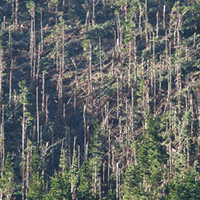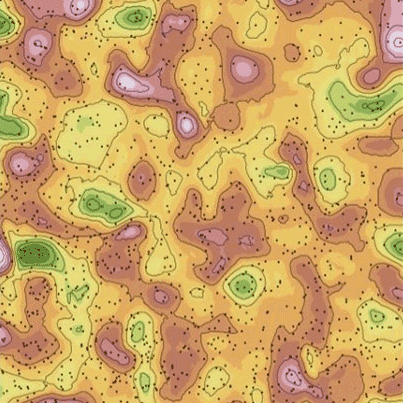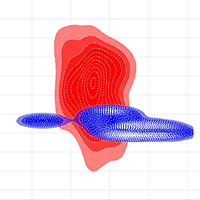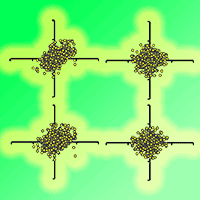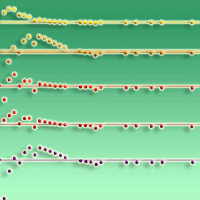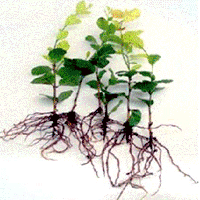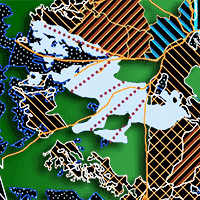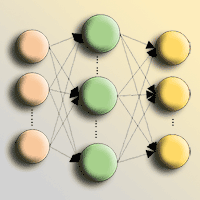In the course of climate change, natural regeneration of oaks (Quercus spp.) is gaining in importance for forest conversion to climate-adapted mixed forests. In order to predict areas in which natural oak regeneration could establish, variables influencing the occurrence and density of oak regeneration were identified using geostatistical zero-altered negative binomial generalized linear models (ZANB). For this purpose, large-scale inventory data from the state forest of Saxony were analysed. The dataset was derived from 6060 permanent plots. The results show that the occurrence of oak regeneration depends on a number of environmental variables. In addition to seed availability, the establishment environment, especially with regard to the light ecology of oak regeneration, was important. High basal area of pine increased the probability for oak regeneration occurrence. The most important variables for the regeneration density of oak have similarly been found to be those describing the seed availability. The highest regeneration densities are predicted within oak stands, with an optimum relationship at 25 m2 ha-1 of oak basal area. The results further show that a high regeneration density was achieved on sites with low fertility and favourable light conditions. Oak regeneration density increased with increasing browsing percent on rowan, indicating that browsing on oak can be reduced if other palatable species are available. Using the identified variables, the occurrence and density of oak regeneration can be predicted in space with high accuracy. The statistical tool developed can be used for planning forest conversion incorporating natural regeneration.
Keywords
, , , , ,
Citation
Axer M, Martens S, Schlicht R, Eisenhauer D-R, Wagner S (2023). Modelling natural regeneration of Oak in Saxony, Germany: identifying factors influencing the occurrence and density of regeneration. iForest 16: 47-52. - doi: 10.3832/ifor4064-015
Academic Editor
Marco Borghetti
Paper history
Received: Jan 11, 2022
Accepted: Dec 22, 2022
First online: Feb 16, 2023
Publication Date: Feb 28, 2023
Publication Time: 1.87 months
© SISEF - The Italian Society of Silviculture and Forest Ecology 2023
Open Access
This article is distributed under the terms of the Creative Commons Attribution-Non Commercial 4.0 International (https://creativecommons.org/licenses/by-nc/4.0/), which permits unrestricted use, distribution, and reproduction in any medium, provided you give appropriate credit to the original author(s) and the source, provide a link to the Creative Commons license, and indicate if changes were made.

Breakdown by View Type
(Waiting for server response...)
Article Usage
Total Article Views: 7569
(from publication date up to now)
Breakdown by View Type
HTML Page Views: 2933
Abstract Page Views: 2668
PDF Downloads: 1548
Citation/Reference Downloads: 3
XML Downloads: 417
Web Metrics
Days since publication: 1032
Overall contacts: 7569
Avg. contacts per week: 51.34
Article Citations
Article citations are based on data periodically collected from the Clarivate Web of Science web site
(last update: Mar 2025)
Total number of cites (since 2023): 4
Average cites per year: 1.33
Publication Metrics
by Dimensions ©
Articles citing this article
List of the papers citing this article based on CrossRef Cited-by.
(1)
Annighöfer P, Beckschäfer P, Vor T, Ammer C (2015)Regeneration patterns of European oak species (
Quercus petraea (Matt.) Liebl.,
Quercus robur L.) in dependence of environment and neighborhood. PloS One 10: 134935.
CrossRef |
Gscholar
(2)
Arvai M, Morgós A, Kern Z (2018)Growth-climate relations and the enhancement of drought signals in pedunculate oak (
Quercus robur L.) tree-ring chronology in Eastern Hungary. iForest - Biogeosciences and Forestry 11: 267-274.
CrossRef |
Gscholar
(3)
Axer M, Martens S, Schlicht R, Wagner S (2021a)Modelling natural regeneration of European beech in Saxony, Germany: identifying factors influencing the occurrence and density of regeneration. European Journal of Forest Resaerch: 1-22.
CrossRef |
Gscholar
(4)
Axer M, Schlicht R, Wagner S (2021b)Modelling potential density of natural regeneration of European oak species (
Quercus robur L.,
Quercus petraea (Matt.) Liebl.) depending on the distance to the potential seed source: methodological approach for modelling dispersal from inventory data at forest enterprise level. Forest Ecology and Management 482: 118802.
CrossRef |
Gscholar
(5)
Barrere J, Petersson LK, Boulanger V, Collet C, Felton AM, Löf M, Saïd S (2021)Canopy openness and exclusion of wild ungulates act synergistically to improve oak natural regeneration. Forest Ecology and Management 487: 118976.
CrossRef |
Gscholar
(6)
Bideau E, Maublanc M-L, Picot D, Hamard J-P, Ballon P, Gerard J-F (2016)Short-term browsing by roe deer has little effect on survival and growth of sessile oak seedlings. Scandinavian Journal of Forest Research 31: 40-45.
CrossRef |
Gscholar
(7)
Brown PE (2015)Model-based geostatistics the easy way. Journal of Statistical Software 63: 1-24.
CrossRef |
Gscholar
(8)
Caignard T, Kremer A, Firmat C, Nicolas M, Venner S, Delzon S (2017)Increasing spring temperatures favor oak seed production in temperate areas. Scientific Reports 7: 8555.
CrossRef |
Gscholar
(9)
Chybicki IJ, Burczyk J (2010)Realized gene flow within mixed stands of
Quercus robur L. and
Q. petraea (Matt.) L. revealed at the stage of naturally established seedling. Molecular Ecology 19: 2137-2151.
CrossRef |
Gscholar
(10)
Clark CJ, Poulsen JR, Levey DJ, Osenberg CW (2007)Are plant populations seed limited? A critique and meta-analysis of seed addition experiments. The American Naturalist 170: 128-142.
CrossRef |
Gscholar
(11)
Collet C, Frochot H (1996)Effects of interspecific competition on periodic shoot elongation in oak seedlings. Canadian Journal of Forest Research 26: 1934-1942.
CrossRef |
Gscholar
(12)
Crawley MJ, Long CR (1995)Alternate bearing, predator satiation and seedling recruitment in
Quercus robur L. Journal of Ecology 83: 683.
CrossRef |
Gscholar
(13)
Demeter L, Molnár AP, Ollerer K, Csóka G, Kiš A, Vadász C, Horváth F, Molnár Z (2021)Rethinking the natural regeneration failure of pedunculate oak: the pathogen mildew hypothesis. Biological Conservation 253: 108928.
CrossRef |
Gscholar
(14)
Dobrowolska D (2006)Oak natural regeneration and conversion processes in mixed Scots pine stands. Forestry 79: 503-513.
CrossRef |
Gscholar
(15)
Dobrowolska D, Kurek P, Olszowska G, Bolibok L (2021)Effects of stand features and soil enzyme activity on spontaneous pedunculate Oak regeneration in Scots pine dominated stands-implication for forest ecosystems. Research Square, art. no. rs-153974, pp. 33. [preprint]
CrossRef |
Gscholar
(16)
Drössler L, Fahlvik N, Wysocka N, Hjelm K, Kuehne C (2017)Natural regeneration in a multi-layered
Pinus sylvestris-Picea abies forest after target diameter harvest and soil scarification. Forests 8: 35.
CrossRef |
Gscholar
(17)
Eisenhauer D-R (1996)Einwanderung der Eichen in Kiefernbestände-Bedeutung für den Waldbau im nordostdeutschen Tiefland [Immigration of oaks into pine stands - Relevance for silviculture in the north-eastern German lowlands]. In: Proceedings of the Silviculture Section of the German Association of Forest Research Institutes, Schopfheim-Wiechs, Germani, pp. 30-43. [in German]
Gscholar
(18)
Fischer H, Huth F, Hagemann U, Wagner S (2016)Developing restoration strategies for temperate forests using natural regeneration processes. In: “Restoration of Boreal and Temperate Forests” (Stanturf JA ed). CRC Press, Boca Raton, FL, USA, pp. 103-164.
Online |
Gscholar
(19)
Gómez JM (2003)Spatial patterns in long-distance dispersal of
Quercus ilex acorns by jays in a heterogeneous landscape. Ecography 26: 573-584.
CrossRef |
Gscholar
(20)
González-Rodríguez V, Navarro-Cerrillo RM, Villar R (2011)Artificial regeneration with
Quercus ilex L. and
Quercus suber L. by direct seeding and planting in southern Spain. Annals of Forest Science 68: 637-646.
CrossRef |
Gscholar
(21)
Götmark F, Berglund A, Wiklander K (2005)Browsing damage on broadleaved trees in semi-natural temperate forest in Sweden, with a focus on oak regeneration. Scandinavian Journal of Forest Research 20: 223-234.
CrossRef |
Gscholar
(22)
Hanley ME, Cook BI, Fenner M (2019)Climate variation, reproductive frequency and acorn yield in English Oaks. Journal of Plant Ecology 12: 542-549.
CrossRef |
Gscholar
(23)
Humphrey JW, Swaine MD (1997)Factors affecting the natural regeneration of
Quercus in Scottish oakwoods. I. Competition from
Pteridium aquilinum. Journal of applied Ecology 34: 577-584.
CrossRef |
Gscholar
(24)
Kaliszewski A (2017)Cost analysis of artificial and natural oak regeneration in selected forest districts. Forest Research Papers 78: 315-321.
CrossRef |
Gscholar
(25)
Kamler J, Dobrovolny L, Drimaj J, Kadavy J, Kneifl M, Adamec Z, Knott R, Martiník A, Plhal R, Zeman J, Hrbek J (2016)The impact of seed predation and browsing on natural sessile oak regeneration under different light conditions in an over-aged coppice stand. iForest - Biogeosciences and Forestry 9: 569-576.
CrossRef |
Gscholar
(26)
Kohler M, Pyttel P, Kuehne C, Modrow T, Bauhus J (2020)On the knowns and unknowns of natural regeneration of silviculturally managed sessile oak (
Quercus petraea (Matt.) Liebl.) forests a literature review. Annals of Forest Science 77.
CrossRef |
Gscholar
(27)
Krainski ET, Gómez-Rubio V, Bakka H, Lenzi A, Castro-Camilo D, Simpson D, Lindgren F, Rue H (2019)Advanced spatial modeling with stochastic partial differential equations using R and INLA. CRC Press, Taylor and Francis Group, Boca Raton, FL, USA, pp. 298.
CrossRef |
Gscholar
(28)
Kunz J, Löffler G, Bauhus J (2018)Minor European broadleaved tree species are more drought-tolerant than
Fagus sylvatica but not more tolerant than
Quercus petraea. Forest Ecology and Management 414: 15-27.
CrossRef |
Gscholar
(29)
Kupferschmid AD (2018)Selective browsing behaviour of ungulates influences the growth of
Abies alba differently depending on forest type. Forest Ecology and Management 429: 317-326.
CrossRef |
Gscholar
(30)
Kurek P, Dobrowolska D (2016)Acorns dispersal by jays
Garrulus glandarius onto clear-cuts and under the forest canopy. Sylwan 160: 512-518.
CrossRef |
Gscholar
(31)
Kurek P, Dobrowolska D, Wiatrowska B (2019)Dispersal distance and burial mode of acorns in Eurasian Jays
Garrulus glandarius in European temperate forests. Acta Ornithologica 53: 155-162.
CrossRef |
Gscholar
(32)
Leuschner C, Ellenberg H (2017)Ecology of central European forests. In: “Vegetation Ecology of Central Europe (6th edn)”, vol. 1. Springer International Publishing AG, Cham, Switzerland.
Online |
Gscholar
(33)
Ligot G, Balandier P, Fayolle A, Lejeune P, Claessens H (2013)Height competition between
Quercus petraea and
Fagus sylvatica natural regeneration in mixed and uneven-aged stands. Forest Ecology and Management 304: 391-398.
CrossRef |
Gscholar
(34)
Lindgren F, Rue H (2015)Bayesian spatial modelling with R-INLA. Journal of Statistical Software 63: 1-25.
CrossRef |
Gscholar
(35)
Löf M, Brunet J, Filyushkina A, Lindbladh M, Skovsgaard JP, Felton A (2016)Management of oak forests: striking a balance between timber production, biodiversity and cultural services. International Journal of Biodiversity Science, Ecosystem Services and Management 12: 59-73.
CrossRef |
Gscholar
(36)
Lüpke VB, Hauskeller-Bullerjahn K (1999)Production forestry without clear felling: will oak become marginalised? Forst und Holz 54 (18): 563-568.
Gscholar
(37)
Manso R, Ligot G, Fortin M (2019)A recruitment model for beech-oak pure and mixed stands in Belgium. Forestry 93: 124-132.
CrossRef |
Gscholar
(38)
Mirschel F, Zerbe S, Jansen F (2011)Driving factors for natural tree rejuvenation in anthropogenic pine (
Pinus sylvestris L.) forests of NE Germany. Forest Ecology and Management 261: 683-694.
CrossRef |
Gscholar
(39)
Modrow T, Kuehne C, Saha S, Bauhus J, Pyttel PL (2020)Photosynthetic performance, height growth, and dominance of naturally regenerated sessile oak (
Quercus petraea [Mattuschka] Liebl.) seedlings in small-scale canopy openings of varying sizes. European Journal of Forest Research 139: 41-52.
CrossRef |
Gscholar
(40)
Mölder A, Meyer P, Nagel R-V (2019a)Integrative management to sustain biodiversity and ecological continuity in Central European temperate oak (
Quercus robur, Q. petraea) forests: an overview. Forest Ecology and Management 437: 324-339.
CrossRef |
Gscholar
(41)
Mölder A, Sennhenn-Reulen H, Fischer C, Rumpf H, Schönfelder E, Stockmann J, Nagel R-V (2019b)Success factors for high-quality oak forest (
Quercus robur, Q. petraea) regeneration. Forest Ecosystems 6: 49.
CrossRef |
Gscholar
(42)
Mosandl R, Kleinert A (1998)Development of oaks (
Quercus petraea (Matt.) Liebl.) emerged from bird-dispersed seeds under old-growth pine (
Pinus silvestris L.) stands. Forest Ecology and Management 106: 35-44.
CrossRef |
Gscholar
(43)
Motta R (2003)Ungulate impact on rowan (
Sorbus aucuparia L.) and Norway spruce (
Picea abies (L.) Karst.) height structure in mountain forests in the eastern Italian Alps. Forest Ecology and Management 181: 139-150.
CrossRef |
Gscholar
(44)
Myczko L, Dylewski L, Zduniak P, Sparks TH, Tryjanowski P (2014)Predation and dispersal of acorns by European Jay (
Garrulus glandarius) differs between a native (Pedunculate Oak
Quercus robur) and an introduced oak species (Northern Red Oak
Quercus rubra) in Europe. Forest Ecology and Management 331: 35-39.
CrossRef |
Gscholar
(45)
Nilsson U, Gemmel P, Lof M, Welander T (1996)Germination and early growth of sown
Quercus robur L. in relation to soil preparation, sowing depths and prevention against predation. New Forest 12: 69-86.
CrossRef |
Gscholar
(46)
Onaindia M, Ametzaga-Arregi I, San Sebastián M, Mitxelena A, Rodríguez-Loinaz G, Peña L, Alday JG (2013)Can understorey native woodland plant species regenerate under exotic pine plantations using natural succession? Forest Ecology and Management 308: 136-144.
CrossRef |
Gscholar
(47)
R Core Team (2018)R: a language and environment for statistical computing. R Foundation for Statistical Computing, Vienna, Austria.
Online |
Gscholar
(48)
Schroder T (2002)On the geographic variation of
Ciboria batschiana (Zopf) Buchwald, the main pathogenic fungus on acorns of
Quercus robur and
Q. petraea in Europe. Dendrobiology 47: 13-19.
Online |
Gscholar
(49)
Shaw MW (1968)Factors affecting the natural regeneration of sessile oak (
Quercus petraea) in North Wales: I. A preliminary study of acorn production, viability and losses. The Journal of Ecology: 565-583.
CrossRef |
Gscholar
(50)
Stähr F, Peters T (2000)Sowing by jays-quality and vitality of natural regenerated oak in North-eastern German lowland. AFZ/Der Wald, Allgemeine Forst Zeitschrift für Waldwirtschaft und Umweltvorsorge 55: 1231-1234.
Online |
Gscholar
(51)
Vrška T, Ponikelsky J, Pavlicová P, Janík D, Adam D (2016)Twenty years of conversion: from Scots pine plantations to oak dominated multifunctional forests. iForest - Biogeosciences and Forestry 10: 75-82.
CrossRef |
Gscholar
(52)
Watt AS (1919)On the causes of failure of natural regeneration in British oakwoods. The Journal of Ecology: 173-203.
CrossRef |
Gscholar
(53)
Ziegenhagen B, Kausch W (1995)Productivity of young shaded oaks (
Quercus robur L.) as corresponding to shoot morphology and leaf anatomy. Forest Ecology and Management 72: 97-108.
CrossRef |
Gscholar
(54)
Zimmermann J, Hauck M, Dulamsuren C, Leuschner C (2015)Climate warming-related growth decline affects
Fagus sylvatica, but not other broad-leaved tree species in Central European mixed forests. Ecosystems 18: 560-572.
CrossRef |
Gscholar
(55)
Zuur AF, Ieno EN, Saveliev AA (2018)Beginner’s guide to spatial, temporal and spatial-temporal ecological data analysis with R-INLA. In: “GAM and Zero-Inflated Models”, vol. 2. Highland Statistics Ltd, Newburgh, UK, pp. 357.
Gscholar



